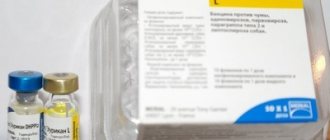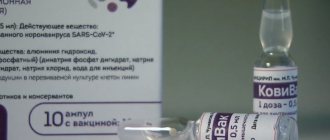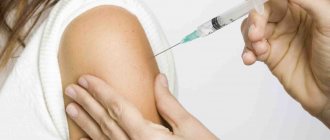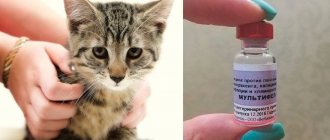Cost of vaccination
| Service | Price | Note |
| RotaTech, USA | 3400 | from 6 to 32 weeks |
Almost every second mother who has one child, and every first mother who has more than one child, knows what “intestinal flu” or rotavirus is.
If the terminology is unfamiliar, then, in any case, absolutely everyone has gone through this disease! In a simplified way, this disease can be characterized as follows: the onset is sudden, the temperature reaches 39 and above, repeated bouts of vomiting, then diarrhea occurs, which lasts on average about 5 days. Naturally, the severity of the disease depends on the general condition of the body and its immunity. The first time the disease is most often quite severe, later, as a rule, it is easier.
Although the entrance gate for rotavirus infection is the oral cavity, from where viruses enter the underlying parts of the intestinal tract, “rotavirus” received its name for its resemblance to a wheel (translated from Latin rota - “wheel”).
Rotaviruses infect almost every child (!) before they reach the age of 3 - 5 years and are the world's main cause of severe diarrhea with dehydration of the body in children under 5 years of age. In developed countries with high incomes, the first episode of infection usually occurs between 2 and 5 years of age, although most cases occur in infants (65% of cases occur before age 1 year).
Every year in the period before the introduction of the vaccine (1986-2000), more than 2 million children worldwide were hospitalized for rotavirus infection. The widespread spread of rotavirus infection even in conditions of high hygienic standards indicates a high level of transmission of this virus.
Currently, there is no specific therapy for rotavirus infection. As with other childhood diarrheas, the main treatment is to restore fluid loss to prevent dehydration.
Vaccinations against rotavirus infection are currently carried out only in the first year of life.
This causes some difficulties.
Practical medical experience in vaccine prevention shows that parents of their first child often do not vaccinate their baby, because are not fully informed about the existence of rotavirus infection and vaccination against it, and are not sure of this need. The desire to vaccinate with Rotatek usually appears when the child is already 2-3 years old or more. Unfortunately, vaccination against rotavirus infection is not provided at this age.
And most often, in children's medical clinics, vaccination against rotavirus infection is carried out for children who already have older brothers and sisters. In other words, parents have already encountered this problem and want to protect their “new” baby from rotavirus infection. Therefore, the most complete and reliable information about the possibility of vaccination against rotavirus infection is the key to preventing this disease in children. In addition, the vaccination is painless for the baby (drops in the mouth), and can be combined with vaccinations with other vaccines.
In European countries, as well as in the United States, vaccination against rotavirus infection has been introduced into the national calendar and has been provided to children since the 1990s.
, USA (RotaTeq®, Merck& Co., USA).
Vaccine options
Current vaccines are based on the production of live attenuated strains of rotavirus of human and/or animal origin that multiply in the human intestine.
There are two rotavirus vaccines on the international market: monovalent (RV1 - Rotarix) and pentavalent (RV5 - RotaTek). The RV1 vaccine is based on a human strain, while the RV5 vaccine contains 5 recombinant viruses based on human and bovine strains. In Russia, the RotaTek vaccine (pentavalent RV5) is used - it is oral and contains 5 recombinants of rotaviruses obtained from human and bovine parent strains of the virus. The interchangeability of RV1 and RV5 vaccines has not been studied.
Vaccination scheme
Three doses of the vaccine are administered. The first dose of the RotaTek vaccine should be administered as soon as possible after the child reaches the age of 1.5 months (6 weeks). Subsequent doses are given 4 to 10 weeks apart, with the final dose of vaccine given before the child reaches 32 weeks (8 months) of age.
Standard recommended RotaTek vaccination schedule: 2-3-4.5 months.
The RotaTek vaccine can be used in premature babies born at at least 25 weeks of gestation. The vaccine should be administered to such children no earlier than 6 weeks after birth.
Vaccination "Rotatek" against rotavirus infection
Home » News » Rotatek vaccination against rotavirus infection
14.09.2017
What is the Rotatek vaccine, which recently appeared in Russia, used for? This vaccine induces immunity to rotavirus infection in humans. According to statistics, rotavirus is responsible for more than half of the hospitalizations of children with acute intestinal diseases. Every year, around the world, about 2 million young patients are admitted for hospital treatment for rotavirus enteritis. This problem is mainly relevant for children under five years of age. An adult is a carrier of rotavirus and rarely gets sick.
The disease is dangerous because it is accompanied by severe vomiting and diarrhea, high fever and dehydration. Sometimes it is also called intestinal flu. In addition, a child often gets sick twice, since rotavirus has many varieties and immunity to one of them does not provide complete protection from the other. In connection with this situation, vaccines against rotaviruses were developed, which are successfully used in 41 countries around the world. One of these vaccinations is the Rotatek vaccine.
- Merck Sharp & Dome Corporation, USA (MERCK SHARP & DOHME, Corp.). The vaccine used in European countries is packaged at a production site in the Netherlands.
| Rotatec contains live cultures of human and bovine rotaviruses of five subtypes: G1, G2, G3, G4 and P1A, as well as excipients that ensure the preservation of microorganisms that cause the most favorable immune response. This combination ensures the development of good protection against viruses that exhibit great variability and constantly change their antigenic structure. |
According to the instructions, Rotatek is used for the prevention of rotavirus infection exclusively in childhood. The vaccine is an oral solution, that is, drops in the mouth. It is packaged in a dispenser tube containing one vaccination dose. The liquid from the tube is squeezed into the child’s mouth onto the inner surface of the cheek. If the baby spits out or regurgitates the vaccine, there is no need to repeat the administration.
Rotatek is compatible with most vaccines used according to the national vaccination schedule. It can be given simultaneously with vaccinations against tetanus, diphtheria, rubella, measles and mumps, hepatitis B virus, Hib infection, pneumococcal and meningococcal infections.
The Rotatec vaccine is compatible with any pertussis vaccine containing an acellular pertussis component. It cannot be vaccinated simultaneously with whole-cell whooping cough vaccines.
Rotatek is also administered simultaneously with inactivated polio vaccines. It is impossible to combine vaccination with vaccination with live oral polio vaccine, since their interaction has not been fully studied. There is evidence that this combination of drugs reduces the immune response to rotavirus.
Timing of Rotatek vaccination
When is Rotatek vaccinated? Since the vaccine is not included in the vaccination calendar, the timing is determined directly by the pediatrician. The Rotatek vaccination scheme is based on the recommendations set out in the instructions for the drug.
- The first dose of the vaccine is given to children between 6 and 12 weeks of age.
- Until what age is Rotatek installed? Before 32 weeks of birth, the full course of these vaccinations must be completed.
- How many times should I do Rotatek? The vaccine is administered three times with an interval of 4–10 weeks between vaccinations.
Thus, the Rotatek chart might look like this:
- age 3–4.5–6 months, which coincides with scheduled vaccinations according to the calendar;
- or 2–4.5–6 months;
- if early protection is necessary, vaccination is carried out in a short time: 6–14–22 weeks.
It is not recommended to administer the first dose after 15 weeks of age. But if such a situation does arise, then the next two doses are administered with a minimum interval of 4 weeks. Revaccination with Rotatek is not required.
How to prepare your child for vaccination
No special preparation is required for the Rotatek vaccination. Both before and after vaccination, the child can eat, drink juices and other liquids, and feed him breast milk.
The drug itself should not be mixed with foreign liquids or food, or other medications.
Mild colds are not a contraindication to vaccination. The drug can be used in premature babies born after 25 weeks of pregnancy.
| The body's reaction to vaccination |
What kind of reaction can a child have to the Rotatek vaccine? The child’s body usually does not react to Rotatek. The vaccine is easily tolerated by the child's body without causing any trouble. In the studies conducted, manifestations of vomiting, diarrhea or fever were noted, which did not exceed the frequency of the same reactions in the group of children without vaccination (placebo).
After vaccination, you can walk outside with your child. You can bathe your baby on the day of vaccination.
It is not advisable to give preventive antipyretics after vaccination, since the temperature rises very rarely and is more often associated with other factors (colds, teething).
The vaccination course should be completed before the age of eight months; revaccination is not required.
| Rotatek is easily tolerated by children, and complications from it are extremely rare and are mainly associated with individual intolerance to the components and immunodeficiency states. At the same time, almost every unvaccinated child under the age of five gets intestinal flu twice. |
For all questions about vaccination, please call: 48-16-41
Vaccination schedule
An approximate immunization schedule looks like the following:
- at 3, 4 and 6 months;
- at 2, 3 and 5 months;
- at 6, 14 and 22 weeks (if early protection is needed).
After 15 weeks, the first dose is not recommended. If there is an urgent need for immunization, only two doses are administered, maintaining an interval of a month.
The duration of the vaccination largely depends on the individual characteristics of the body and varies from two to three years.
Compatibility with other vaccines
The compatibility with other vaccines of the Rotatec drug deserves special attention. It can be administered simultaneously with almost all drugs included in the vaccination calendar.
Simultaneous use with medications that protect against the following diseases is allowed:

tetanus;- rubella;
- Hib infection;
- diphtheria;
- meningococcal infection;
- hepatitis B virus;
- mumps;
- measles;
- pneumococcal infection.
Rotatek is also compatible with pertussis vaccines, but only those containing acellular virus. It is not used with whole cell preparations.
Simultaneous use with inactivated polio vaccinations is allowed.
Rotatec cannot be combined with oral live polio vaccine. The interaction of these medications has not been fully studied. This combination is thought to reduce the immune response to rotavirus.
Contraindications
The main contraindications for vaccination against rotavirus infection are a severe allergic reaction to the previous dose and severe immunodeficiency. Cautions for the use of rotavirus vaccine include a history of intussusception or intestinal malformations, chronic gastrointestinal diseases, and acute severe illness. Vaccination should be postponed if the child has acute gastroenteritis or fever due to severe or moderate illness.
SIDE EFFECTS
The vaccine is generally well tolerated.
In children participating in three placebo-controlled clinical trials (6130 children in the vaccine group, 5560 children in the placebo group), the side effects of RotaTek were assessed for 42 days after vaccination with or without concomitant use of other childhood vaccines. Overall, adverse reactions were reported in 47 children receiving the Rota Tek vaccine, compared with 45.8 in the placebo group. The most common adverse events were hyperthermia (temperature above 38°C) (20.9), diarrhea (17.6) and vomiting (10.1).
Serious adverse reactions were assessed in all participants (36,150 children in the vaccine group, 35,536 children in the placebo group) in 3 clinical studies within 42 days after each dose. Overall, the incidence of serious adverse reactions was 0.1 in the vaccine group and 0.2 in the placebo group. Adverse reactions in the vaccine group are listed below according to the organ/class system. Based on pooled data from 3 clinical studies (6130 children in the vaccine group, 5560 children in the placebo group), adverse reactions are listed, the frequency of which in the vaccine group exceeded the frequency in the placebo group by 0.2-2.5. Adverse reactions in italics were observed in the post-marketing period (including spontaneous reports). The frequency of adverse reactions was determined as follows: very often k 1 /1 O), often (~1/100, but <1/1 O), infrequently (~1/1000, but <1/100), rarely (~1/100) 10000, but <1/1000), unknown (the frequency of these adverse reactions cannot be determined from the available data).
Infectious and parasitic diseases
- Common:
Upper respiratory tract infections; - Uncommon:
Nasopharyngitis, Otitis media.
Immune system disorders
- Unknown:
Anaphylactic reaction.
Respiratory, thoracic and mediastinal disorders
- Rarely:
Bronchospasm.
Gastrointestinal disorders
- Very common:
Diarrhea, Vomiting; - Uncommon:
Hematochezia, Upper abdominal pain; - Rare:
Intussusception.
Skin and subcutaneous tissue disorders
- Uncommon:
Rash; - Rarely:
Urticaria; - Unknown:
Angioedema. - Very common:
Hyperthermia.
General and administration site disorders
Additional Information
Kawasaki disease occurred in 5 of 36,150 children in the 0.1 vaccine group and 1 of 35,536 in the 0.1 placebo group, with a relative risk of 4.9 [95 CI: 0.6;239.1] (not statistically significant ). Data from post-registration studies do not confirm an increase in the risk of Kawasaki disease after vaccination with RotaTek" (see "Immunological properties").
The risk of intussusception was assessed in a placebo-controlled study. When observed for 42 days after each dose, there were 6 cases of intussusception in the RotaTek vaccine group (34,837 patients) and 5 cases in the placebo group (34,788 patients). There was no relationship between the development of intussusception and time after administration of either dose.
Data from post-registration studies do not confirm an increased risk of intussusception after vaccination with RotaTek" (see "Immunological properties").
Special patient groups
During post-registration surveillance of children with severe combined immunodeficiency, cases of gastroenteritis caused by rotavirus strains included in the vaccine were noted.
There is a risk of developing apnea in premature babies (born before 28 weeks of gestation.
Preparing for vaccination
No special preparation is required for the procedure. It is enough to show the child to the doctor on the day of vaccination.
The pediatrician assesses his condition, excludes possible contraindications and decides on the possibility of immunization.
After administration of the drug, children should not be restricted in drinking and eating. There is no need to force feed the baby or introduce new foods to the menu.
During the post-vaccination period, it is not prohibited to walk in the fresh air if weather conditions permit. The main thing is to avoid crowded places.
If your child is prone to allergies, you should discuss with your pediatrician the need to take antihistamines. The doctor selects the medication on an individual basis.
What side effects may there be?
Despite the fact that Rotatec is most often well tolerated, side effects are sometimes observed during vaccination. Among them:

loss of appetite;- apathy;
- excessive sleepiness;
- rashes on the skin;
- loose stool;
- hyperthermia.
If such symptoms appear, you need to carefully monitor the baby’s condition.
If you notice a deterioration in your health, and side effects become pronounced, you need to seek help from a doctor..
Possible complications
In the post-vaccination period, serious complications may develop. They are observed with contraindications to vaccination.
In this case, the following negative changes may be observed:

severe forms of allergic reaction;- gagging, causing dehydration;
- intussusception;
- volvulus;
- formation of ulcers and erosion;
- internal bleeding.
Vaccine effectiveness
WHO recommends preventive vaccination as an effective remedy against rotavirus. Current vaccines demonstrate 80–90% effectiveness against severe rotavirus gastroenteritis (RVGE) in countries with very low or low mortality rates in children and adults, and 40–60% effectiveness in countries with high mortality rates in children and adults. high or very high mortality rates among adults. In developed countries, a decrease in the incidence of RVGE was observed several years after immunization. In Mexico and Brazil, vaccination resulted in a 22% to 28% reduction in diarrhea-related deaths among children 2 years of age and younger.
In most cases, vaccination in infancy provides protection against severe RVGE for at least 2 years (the period of greatest risk).
Infants can receive rotavirus vaccine along with DTP, regardless of the time of vaccination. Rotavirus vaccinations for children over 2 years of age are not considered inappropriate. Rotavirus vaccines may be given at the same time as other routine childhood vaccines except live oral polio vaccine.
Composition of the vaccine
Rotatec contains reassortants of the following types of rotaviruses:

G1;- G2;
- G3;
- G4;
- P1A [8].
The vaccine also contains auxiliary components:
- sodium hydroxide;
- sucrose;
- rotavirus solvent;
- polysorbate-80;
- sodium dihydrogen phosphate monohydrate;
- sodium citrate dihydrate.
Alive or not
Rotatek is a live vaccine. It contains weakened pathogens of rotavirus infection of five strains.










